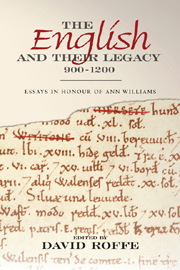Book contents
- Frontmatter
- Contents
- Figures and Tables
- Dedication
- Preface
- Contributors
- Abbreviations
- Ann Williams: a Personal Appreciation
- Life-writing and the Anglo-Saxons
- Meet the Swarts: Tracing a Thegnly Family in Late Anglo-Saxon England
- The Moneyers of Kent in the Long Eleventh Century
- Master Wace: a cross-Channel Prosopographer for the Twelfth Century?
- From Minster to Manor: the Early History of Bredon
- Eadulfingtun, Edmonton, and their Contexts
- The Family of Wulfric Spott: an Anglo-Saxon Mercian Marcher Dynasty?
- The Burial of King Æthelred the Unready at St Paul's
- Eustace II of Boulogne, the Crises of 1051–2 and the English Coinage
- Through the Eye of the Needle: Stigand, the Bayeux Tapestry and the Beginnings of the Historia Anglorum
- Robert of Torigni and the Historia Anglorum
- Invoking Earl Waltheof
- Hidden Lives: English Lords in post-Conquest Lincolnshire and Beyond
- Lordship and Lunching: Interpretations of Eating and Food in the Anglo-Norman World, 1050–1200, with Reference to the Bayeux Tapestry
- The Exchequer Cloth, c. 1176–1832: the Calculator, the Game of Chess, and the Process of Photozincography
- Ann Williams: a Bibliography 1969–2011
- Index
- Tabula Gratuloria
Through the Eye of the Needle: Stigand, the Bayeux Tapestry and the Beginnings of the Historia Anglorum
Published online by Cambridge University Press: 05 April 2013
- Frontmatter
- Contents
- Figures and Tables
- Dedication
- Preface
- Contributors
- Abbreviations
- Ann Williams: a Personal Appreciation
- Life-writing and the Anglo-Saxons
- Meet the Swarts: Tracing a Thegnly Family in Late Anglo-Saxon England
- The Moneyers of Kent in the Long Eleventh Century
- Master Wace: a cross-Channel Prosopographer for the Twelfth Century?
- From Minster to Manor: the Early History of Bredon
- Eadulfingtun, Edmonton, and their Contexts
- The Family of Wulfric Spott: an Anglo-Saxon Mercian Marcher Dynasty?
- The Burial of King Æthelred the Unready at St Paul's
- Eustace II of Boulogne, the Crises of 1051–2 and the English Coinage
- Through the Eye of the Needle: Stigand, the Bayeux Tapestry and the Beginnings of the Historia Anglorum
- Robert of Torigni and the Historia Anglorum
- Invoking Earl Waltheof
- Hidden Lives: English Lords in post-Conquest Lincolnshire and Beyond
- Lordship and Lunching: Interpretations of Eating and Food in the Anglo-Norman World, 1050–1200, with Reference to the Bayeux Tapestry
- The Exchequer Cloth, c. 1176–1832: the Calculator, the Game of Chess, and the Process of Photozincography
- Ann Williams: a Bibliography 1969–2011
- Index
- Tabula Gratuloria
Summary
Who commissioned the Bayeux Tapestry and why? The question remains open after a considerable body of innovative new writing on the subject during the last decade has given grounds for a major re-evaluation of the Tapestry. Two ideas in particular demand fuller investigation: first, that the Tapestry is an independent, pro-English, source, artistically the first major fusion of Anglo-Norman-Scandinavian iconography and linguistically influenced by both English and French, and secondly, that it was produced as early as 1068 x 1070, since it precedes the Norman vilification of Harold that arose as a response to the various revolts that began in May 1068. Despite the ingenuity of attempts to demonstrate the contrary intention from the curious figures appearing in the borders, the fact is that not a single pejorative is ever attached to Harold in the tituli of the work. Recent detailed studies of the depictions of Harold show him to have been represented with honour even in the tightest of corners. The Tapestry therefore certainly predates the systematic assault on Harold as a perjured usurper, and thus a tyrant whose reign was thereby nullified, which was the legal case fashioned by Archbishop Lanfranc of Canterbury and subsequently presented at Rome, as demonstrated nearly twenty years ago by George Garnett. A similar assault was made on the prelacy and memory of Lanfranc's predecessor Stigand, who had controversially been appointed whilst the archbishop ousted in 1052 still lived. A more longstanding tendency to date the Tapestry to 1070 x 1082, with Bishop Odo as the generally assumed patron, has entailed some fairly contorted attempts to understand the inter-relationships between this and contemporary or near contemporary written sources.
- Type
- Chapter
- Information
- The English and their Legacy, 900–1200Essays in Honour of Ann Williams, pp. 159 - 174Publisher: Boydell & BrewerPrint publication year: 2012



